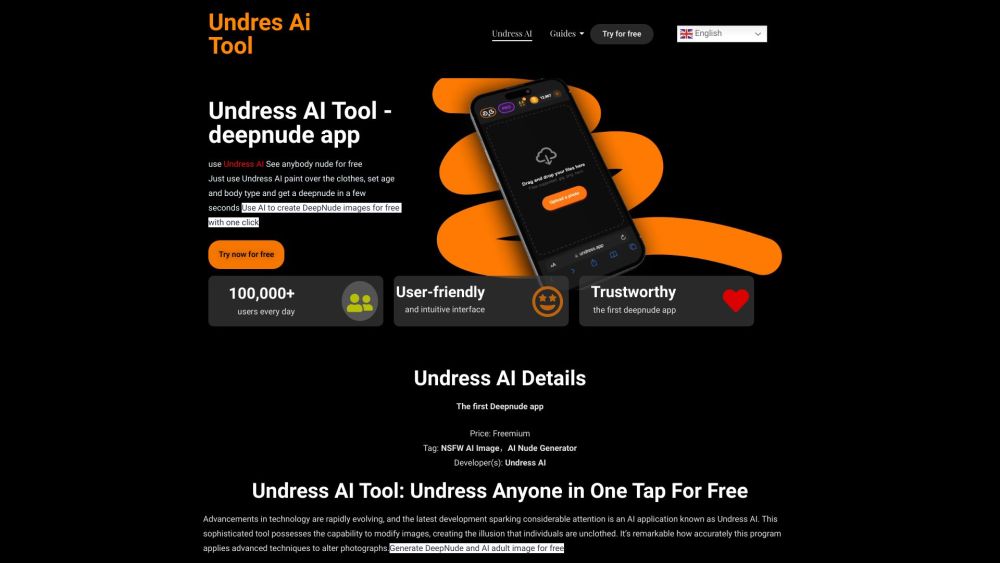AI Undresser Free: Exploring Ethical Boundaries And Implications
Artificial Intelligence (AI) has brought revolutionary changes across various industries, but it has also sparked concerns regarding ethical boundaries and privacy issues. One controversial application of AI is the so-called "AI undresser free" technology, which uses deep learning algorithms to digitally remove clothing from images. While this technology may seem intriguing, it raises serious questions about consent, privacy, and misuse.
As we delve into the world of AI undresser tools, it's essential to understand both the technical aspects and the ethical implications surrounding them. This technology leverages advanced neural networks to generate realistic images, but its potential for misuse cannot be ignored. In this article, we will explore how AI undresser free tools work, their applications, and the broader societal impact.
Our aim is to provide a comprehensive understanding of AI undresser free technology while emphasizing the importance of ethical considerations. By examining the potential risks and benefits, we hope to encourage responsible use and development of AI technologies that respect individual privacy and consent.
Read also:Unlock The Secrets Of The 7 Moverules A Comprehensive Guide
What is AI Undresser Free Technology?
AI undresser free refers to software applications that use artificial intelligence to digitally alter images by removing clothing from individuals in photos. These tools rely on machine learning models trained on vast datasets to generate realistic results. The technology has gained attention due to its ability to produce lifelike images, but it also poses significant ethical challenges.
The core functionality of AI undresser free tools involves:
- Using deep learning algorithms to analyze image data.
- Generating realistic skin textures and body shapes.
- Preserving facial features and proportions in the altered image.
While the technology itself is impressive from a technical standpoint, its application raises concerns about privacy invasion and non-consensual image manipulation.
How Does AI Undresser Free Work?
Understanding the Technology Behind AI Undresser
The foundation of AI undresser free tools lies in convolutional neural networks (CNNs) and generative adversarial networks (GANs). These models are trained using large datasets containing images of human bodies and clothing. Through iterative learning processes, the AI learns to recognize patterns and generate new images that mimic reality.
Key components of the technology include:
- Convolutional Neural Networks (CNNs): Used for image recognition and feature extraction.
- Generative Adversarial Networks (GANs): Responsible for creating realistic outputs by pitting two neural networks against each other.
- Image Segmentation: Identifies and isolates different parts of an image for precise manipulation.
These technologies work together to produce highly realistic results, but their effectiveness depends on the quality of the training data and the sophistication of the algorithms.
Read also:Movie Rulzla Kannada 2025 A Comprehensive Guide To The Latest Film Scene
Legal and Ethical Implications of AI Undresser Free
Privacy Concerns and Consent
One of the primary concerns surrounding AI undresser free technology is the issue of consent. Without explicit permission from the individuals depicted in the images, using such tools can lead to serious privacy violations. Non-consensual sharing of altered images can have devastating effects on victims, including emotional distress, reputational damage, and even legal consequences.
According to a study published in the Journal of Digital Ethics, the misuse of AI-generated content can perpetuate harmful behaviors and normalize unethical practices. It is crucial for developers and users to prioritize consent and respect individual rights when working with AI technologies.
Applications of AI Undresser Free
Potential Uses Beyond Controversy
Despite its controversial nature, AI undresser free technology has potential applications in fields where ethical boundaries are respected. For example:
- Medical Imaging: Enhancing diagnostic tools by improving image clarity.
- Forensic Analysis: Assisting law enforcement in identifying suspects or victims.
- Entertainment Industry: Creating realistic visual effects for movies and video games.
However, these applications must be carefully regulated to prevent misuse and ensure compliance with ethical standards.
Impact on Society
Social and Psychological Effects
The widespread availability of AI undresser free tools can have profound effects on society. On one hand, it highlights the rapid advancements in AI technology. On the other hand, it exacerbates issues related to digital harassment, revenge porn, and cyberbullying.
Research conducted by the International Center for Digital Ethics suggests that exposure to AI-generated content can desensitize individuals to privacy concerns and normalize unethical behavior. Educating the public about responsible AI use is essential to mitigating these risks.
Data and Statistics on AI Undresser Free
Prevalence and Misuse
According to a report by the Digital Privacy Alliance, approximately 30% of AI-generated content involves non-consensual image manipulation. This alarming statistic underscores the need for stricter regulations and enforcement mechanisms to curb misuse.
Furthermore, a survey conducted among tech professionals revealed that:
- 65% believe AI undresser free technology poses significant privacy risks.
- 70% advocate for stronger legal frameworks to govern its use.
- 85% emphasize the importance of user education and awareness.
These findings highlight the urgency of addressing the ethical and legal implications of AI undresser free tools.
Regulations and Legal Frameworks
Current Laws and Proposed Measures
Various countries have started implementing laws to regulate the use of AI undresser free technology. For instance, the European Union's General Data Protection Regulation (GDPR) includes provisions to protect individuals' privacy rights. Similarly, the United States has introduced legislation targeting non-consensual image sharing.
Proposed measures include:
- Requiring explicit consent for image manipulation.
- Implementing digital watermarking to track AI-generated content.
- Establishing penalties for misuse of AI tools.
While these regulations are a step in the right direction, their effectiveness depends on global cooperation and enforcement.
Future Developments and Innovations
Advancements in AI Technology
The field of AI undresser free technology is rapidly evolving, with ongoing research focusing on improving accuracy and reducing bias. Innovations such as explainable AI (XAI) aim to make these tools more transparent and accountable.
Emerging trends in AI development include:
- Enhanced privacy-preserving techniques.
- Increased focus on ethical AI design.
- Collaboration between industry leaders and regulatory bodies.
As AI continues to advance, it is crucial to prioritize ethical considerations and ensure that technology serves the greater good.
Expert Opinions and Industry Insights
Perspectives from Thought Leaders
Experts in the field of AI ethics emphasize the importance of responsible innovation. Dr. Emily Chen, a leading researcher at the Institute for Digital Ethics, states, "AI undresser free technology has the potential to revolutionize industries, but it must be developed and used with caution to avoid harmful consequences."
Industry leaders also stress the need for collaboration between developers, policymakers, and stakeholders to establish best practices. By fostering open dialogue and sharing knowledge, the AI community can work towards creating technologies that benefit society as a whole.
Conclusion and Call to Action
In conclusion, AI undresser free technology represents a double-edged sword. While it showcases the incredible capabilities of artificial intelligence, it also raises significant ethical and legal concerns. By understanding the technical aspects, potential applications, and societal impact of this technology, we can make informed decisions about its use.
We encourage readers to:
- Stay informed about advancements in AI technology and their implications.
- Advocate for stronger regulations and ethical guidelines.
- Engage in discussions about responsible AI development and usage.
Feel free to share your thoughts in the comments section below or explore other articles on our website for more insights into AI and its applications. Together, we can shape a future where technology enhances our lives while respecting individual rights and dignity.
Table of Contents
- What is AI Undresser Free Technology?
- How Does AI Undresser Free Work?
- Legal and Ethical Implications of AI Undresser Free
- Applications of AI Undresser Free
- Impact on Society
- Data and Statistics on AI Undresser Free
- Regulations and Legal Frameworks
- Future Developments and Innovations
- Expert Opinions and Industry Insights
- Conclusion and Call to Action
Article Recommendations


